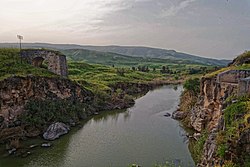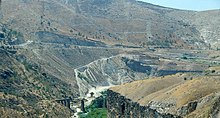geo.wikisort.org - River
The Yarmuk River (Arabic: نهر اليرموك, romanized: Nahr al-Yarmūk, Hebrew: נְהַר הַיַּרְמוּךְ, romanized: Nahar HaYarmukh; Greek: Ἱερομύκης, Hieromýkēs; Latin: Hieromyces[1] or Heromicas;[2] sometimes spelled Yarmouk),[3] is the largest tributary of the Jordan River.[4] It runs in Jordan, Syria and Israel, and drains much of the Hauran plateau. Its main tributaries are the wadis of 'Allan and Ruqqad from the north, Ehreir and Zeizun from the east. Although it is narrow and shallow throughout its course, at its mouth it is nearly as wide as the Jordan, measuring thirty feet in breadth and five in depth. The once celebrated Matthew Bridge used to cross the Yarmuk at its confluence with the Jordan.[5]
| Yarmuk | |
|---|---|
 Yarmuk River near the Naharayim/Baqura Area | |
| Native name |
|
| Location | |
| Country | Syria, Jordan, Israel |
| Region | Middle East, Eastern Mediterranean littoral |
| Physical characteristics | |
| Source | |
| • location | Hauran |
| Mouth | Jordan River |
• location | Naharayim/Baqura Area Israel/Jordan |
• coordinates | 32°38′39″N 35°34′22″E |
| Length | Approx. 70 km (43 mi) |
| Basin size | Approx. 7,000 km2 (2,700 sq mi) |
| Discharge | |
| • average | 14.5 m3/s (510 cu ft/s) |
| Basin features | |
| Tributaries | |
| • left | Ruqqad, 'Allan |
| • right | Ehreir, Zeizun |
History
Yarmuk forms a natural border between the plains to the north - Hauran, Bashan and Golan - and the Gilead mountains to the south. Thus it has often served as boundary line between political entities.[6]

Neolithic
The Yarmukian is a Pottery Neolithic culture that inhabited parts of Palestine and Jordan.[dubious ] Its type site is at Sha'ar HaGolan, on the river mouth[dubious ].[7]
Bronze Age

Early Bronze Age I is represented in the Golan only in the area of the river.[7]
Abila (Tel Abil) is attested in the 14th-century BC Amarna Letters. This is possibly the case also for Geshur, assumed to have lain north of the river.[6] Other historical cities on the course of the river are Dara'a, Heet, Jalin; and the archaeological sites of Tell Shihab and Khirbet ed-Duweir (See Lo-debar).[6]
Iron Age
The Aramean kingdoms and the northern Kingdom of Israel, of the Hebrew Bible, might have set their boundary line along the Yarmouk occasionally. Under the Assyrian and Persian empires the province of Ashteroth Karnaim laid to the north, and that of Gal'azu (Gilead) to the south.[6]
Hellenistic period
In Hellenistic times, the territory of Hippos was across from those of Gadara and Abila (Abel) on the south, while Dion sat on the eastern tributaries.[6]
Byzantine period
The Battle of the Yarmuk, where Muslim forces defeated those of the Byzantine Empire and gained control of Syria, took place north of the river in 636.
1905–1948
A fork of the Hejaz Railway (connecting to the Jezreel Valley railway in Samakh) ran in the river valley from 1905 to 1946.[8] It was deprecated after being bombed by the Jewish Haganah in the Night of the Bridges on 16 June 1946. The hydroplant of Naharayim, on the confluence with Jordan River, served Mandatory Palestine from 1932 to 1948.[9]
After 1948

Today, the lower part of the river, close to the Jordan Valley, forms part of the border between Israel and Jordan. Further upstream it forms part of the border between Syria and Jordan (a border largely inherited from the 1923 Franco-British Boundary Agreement). The area of Al-Hamma, or Hamat Gader in the valley is held by Israel but claimed by Syria.
The Al-Wehda Dam was constructed on the border between Jordan and Syria in the 2000s. There are political agreements between Jordan and Syria (1953 and 1987) and between Jordan and Israel (1994), about the management and allocation of the shared waters of the Yarmouk River.[9]
References
- Meyers, E. M.; Brown, J. P. (October 27, 2017). "Hieromyces (river): a Pleiades place resource". Pleiades: a gazetteer of past places.
- "TM Places". www.trismegistos.org.
- Schürer, Emil (2014-01-30). The History of the Jewish People in the Age of Jesus Christ. A&C Black. page 133, note 243. ISBN 9781472558299. Retrieved 2021-04-07.
- It is one of three main tributaries which enter the Jordan between the Sea of Galilee and the Dead Sea; to the south there are the Zarqa (Jabbok) and the Mujib (Arnon) rivers.
- "YARMUK - JewishEncyclopedia.com". jewishencyclopedia.com.
- Ma'oz, p. 420
- Ma'oz, Zvi Uri (1997). "Golan". The Oxford Encyclopedia of Archaeology in the Near East. p. 418. ISBN 978-0195112153.
- Yarmuk River railway bridges, 1933 aerial photographs. Aerial Photographic Archive for Archaeology in the Middle East / National Archives, London.
- Hussein, Hussam, and Mattia Grandi. "Dynamic political contexts and power asymmetries: the cases of the Blue Nile and the Yarmouk Rivers." International Environmental Agreements: Politics, Law and Economics (2017): 1-20.
External links
 This article incorporates text from a publication now in the public domain: Singer, Isidore; et al., eds. (1901–1906). "Yarmuk (modern Shari'at al-Manaḍirah)". The Jewish Encyclopedia. New York: Funk & Wagnalls.
This article incorporates text from a publication now in the public domain: Singer, Isidore; et al., eds. (1901–1906). "Yarmuk (modern Shari'at al-Manaḍirah)". The Jewish Encyclopedia. New York: Funk & Wagnalls.- Yarmouk Hydro-Political Story Map by the UEA Water Security Research Centre
- Photos of Yarmouk river at the American Center of Research
На других языках
[de] Jarmuk
Der Jarmuk (auch Yarmuk, arabisch نهر اليرموك Nahr al-Yarmūk, DMG nahru ʾl-Yarmūk, hebräisch .mw-parser-output .Hebr{font-size:115%}נָהָר הַיַּרְמוּךְ .mw-parser-output .Latn{font-family:"Akzidenz Grotesk","Arial","Avant Garde Gothic","Calibri","Futura","Geneva","Gill Sans","Helvetica","Lucida Grande","Lucida Sans Unicode","Lucida Grande","Stone Sans","Tahoma","Trebuchet","Univers","Verdana"}Nahar haJarmūch, lateinisch Hieromyces) ist der größte Nebenfluss des Jordan. Er bildet die Grenze zwischen Syrien und Jordanien und kurz vor der Einmündung in den Jordan zwischen Israel und Jordanien.- [en] Yarmouk River
[es] Río Yarmuk
El río Yarmuk (en árabe, نهر اليرموك, Nahr Al-Yarmuk; en hebreo, נהר הירמוך, Nahar HaYarmukh) es el mayor afluente del río Jordán. Con unos 70 km de largo, tiene un caudal de 475 millones de m³ al año.[1] Recoge el agua de la meseta de Haurán y es uno de los tres tributarios principales del Jordán entre el mar de Galilea y el mar Muerto. Los otros son el río Zarqa (antiguamente Jaboc) y el río Arnon, ambos al sur.[it] Yarmuk
Lo Yarmùk (arabo: نهر اليرموك Nahr al-Yarmuk; ebraico: נְהַר הַיַּרְמוּךְ Nahar ha-Yarmuch; greco: Ἱερομύκης Hieromýkēs; latino: Hieromyces[1] o Heromicas[2]) è un fiume periodico, maggior affluente del Giordano.[ru] Ярмук
Ярму́к (араб. اليرموك, ивр. נַחַל הַיַּרְמוּךְ Нахаль ха-Ярмух) — река на Ближнем Востоке. Крупнейший приток реки Иордан. Одна из немногих непересыхающих рек в этом районе. Длина — 70 км[источник не указан 4039 дней]. Годовой сток реки составляет в среднем 460 миллионов м³.[источник не указан 4039 дней]Другой контент может иметь иную лицензию. Перед использованием материалов сайта WikiSort.org внимательно изучите правила лицензирования конкретных элементов наполнения сайта.
WikiSort.org - проект по пересортировке и дополнению контента Википедии